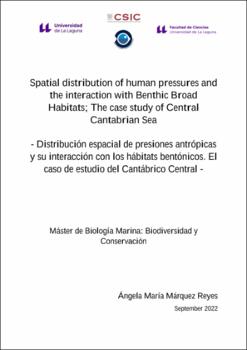Spatial distribution of human pressures and the interaction with Benthic Broad Habitats; The case study of Central Cantabrian Sea
Fecha
2022Resumen
Como consecuencia del elevado solapamiento de actividades en el ecosistema marino, surgen
una serie de marcos de actuación para la protección de este medio, entre los cuales destaca la
Directiva Marco de Estrategias Marinas (DMEM). En el presente trabajo se busca caracterizar
las presiones que tienen una afección sobre el Descriptor 6 (D6), integridad del fondo marino,
así como establecer una primera aproximación sobre las áreas de acumulación de estas. Para
ello se ha realizado una recopilación de las actividades humanas que ocurren en el Mar
Cantábrico central, las presiones que pueden ejercer, su zona de influencia y los hábitats
bentónicos con los que solapan. Los resultados muestran que el Mar Cantábrico se encuentra
altamente afectado, el 10% presenta pérdida física (1617,18 km2
) y el 42% del área estudiada
está perturbada (6556,13 km2
). De hecho, 14 de los 21 hábitats estudiados mostraron más del
50% de su superficie afectada por la presión humana. La pesca es la actividad con mayor
relevancia que afecta a la integridad de los fondos marinos (7415,19 km2
), ocurriendo esta
actividad mayoritariamente sobre los fondos sedimentarios. La acumulación de las presiones
se da en mayor medida en los hábitats litorales, donde los hábitats rocosos presentan un alto
porcentaje de afección, siendo la fuente de esta acumulación la interacción entre diferentes
artes de pesca (palangre y enmalle) en zonas de la plataforma y el talud (entre los 113-644 m)
y la interacción de diferentes actividades en la costa. El resultado, son amplias zonas con
presencia de presiones acumuladas, destacando la gran afección sobre el Lugar de Interés
Comunitario (LIC) del sistema de cañones de Avilés, donde se acumulan hasta 3-4 presiones
mayormente proveniente de la pesca. El estudio de la serie espaciotemporal de la pesca
muestra un aumento general del esfuerzo de las artes fijas (35/40%) y una disminución
general de las artes móviles (36/53%). El elevado solapamiento encontrado, así como el
creciente uso de los espacios marinos, hace necesario el análisis minucioso de estas presiones para una correcta gestión de los ecosistemas y espacios protegidos.
Palabras clave: Estrategias Marinas, hábitats, integridad de los fondos marinos, presiones
acumuladas. The high overlap of activities in the marine ecosystem has driven the development of several
frameworks for the protection of the marine ecosystem, among them, the Marine Strategies
Framework Directive (MSFD) stands out. The present work aims to characterize the pressures
that affect Descriptor 6 (D6), seabed integrity, and to establish the first approximation of the
pressure accumulation analysis. To do it, a detailed compilation of the spatial distribution of
the human activities that occur in the Central Cantabrian Sea, the pressures they may exert,
the area of influence, and the overlapped benthic habitats have been conducted. The results
showed that Central Cantabrian Sea is highly affected, the 10% of the seabed is physically
lost (1617.18 km2
) and 42% of the surveyed area was disturbed (6556.13 km2
), in fact, 14 of
the 21 studied habitats showed more than the 50% of their area affected by human pressures.
Fishing is the activity exerting the greatest pressure on seabed integrity (7415.19 km2
) mostly
occurring along sedimentary habitats. The results also showed that the pressures accumulation
occurred mostly along coastal habitats, where rocky habitats present a high percentage of
affection, being the source of this accumulation the interaction between different fishing gears
(longline and gillnet) in deeper continental shelf and slopes (between 113 -644 m depth) and
the interaction of different activities on the coast. The Site of Community Importance (SCI)
Avilés Canyon System area also showed a high accumulation of pressures where up to 3-4
pressures were found, mostly fishing activities. The time series of fishing analyzed showed a
general increasing trend of static gears (35/40%) while a general decrease trend of mobile
gears (36/53%) was found. The high overlap found between pressures, as well as the
increasing use of marine areas, makes it necessary to conduct a more detailed analysis of these pressures for the correct management of ecosystems and protected areas.
Keywords: Cumulative pressures, habitats, Marine Strategies, seabed integrity





